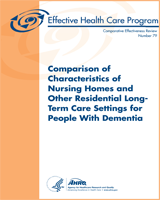This publication is provided for historical reference only and the information may be out of date.
Comparison of Characteristics of Nursing Homes and Other Residential Long-Term Care Settings for People With Dementia
Comparative Effectiveness Reviews, No. 79
Authors
Investigators: Sheryl Zimmerman, PhD, Wayne Anderson, PhD, Shannon Brode, MPH, Dan Jonas, MD, MPH, Linda Lux, MPA, Anna Beeber, PhD, RN, Lea Watson, MD, MPH, Meera Viswanathan, PhD, Kathy Lohr, PhD, Jennifer Cook Middleton, PhD, LeRon Jackson, MD, and Philip Sloane, MD, MPH.Affiliations
Structured Abstract
Objectives:
To compare characteristics and related outcomes of nursing homes (NHs) and other residential long-term care settings for people with dementia so as to reduce uncertainty when choosing a setting of care for someone with dementia.
Data Sources:
We searched MEDLINE®, Embase®, the Cochrane Library, the Cumulative Index to Nursing and Allied Health Literature (CINAHL®), AgeLine®, and PsycINFO® from 1990 through March 23, 2012. We identified additional studies from reference lists and experts.
Review methods:
Two people independently selected, abstracted data from, and rated the quality of relevant studies. Given that quantitative analyses were inappropriate because of clinical heterogeneity, insufficient numbers of similar studies, or insufficient or variation in outcome reporting, we synthesized the data qualitatively. Two reviewers graded the strength of evidence (SOE) using established criteria.
Results:
We identified 14 studies meeting our inclusion criteria. Generally, studies examined characteristics, structures, and process of care for populations with mild to severe dementia. Ten studies addressed health outcomes (Key Question [KQ] 1), and 10 examined psychosocial outcomes (KQ 2) for people with dementia. No eligible studies examined health or psychosocial outcomes for informal caregivers (KQ 3 and KQ 4, respectively). The studies included four prospective cohort studies, nine randomized controlled trials (RCTs), and one non-RCT. Two studies showed that the use of pleasant sensory stimulation reduces agitation. We found limited evidence on a number of interventions, including protocols for individualized care to reduce pain/discomfort and agitation/aggression and functional skill training to improve function. We found largely no differences across outcomes including function, cognition, depressive symptoms, pain, morbidity, behavioral symptoms, engagement, and quality of life based on residence in an NH or residential care/assisted living (RC/AL), other than increased hospitalization for people with mild dementia in RC/AL compared with NHs and increased restraint use in NHs compared with RC/AL for imminently dying residents.
Conclusions:
Overall, we found low or insufficient SOE regarding the effect of organizational characteristics, structures, and processes of care on health and psychosocial outcomes for people with dementia and no evidence for informal caregivers. Findings of moderate SOE indicate that pleasant sensory stimulation reduces agitation. Also, although the SOE is low, protocols for individualized care and to improve function result in better outcomes. Finally, outcomes do not differ between NHs and RC/AL except when medical care is indicated. Additional research is needed to develop a sufficient evidence base to support decisionmaking.
Prepared for: Agency for Healthcare Research and Quality, U.S. Department of Health and Human Services1, Contract No. 290-2007-10056-I. Prepared by: RTI International–University of North Carolina Evidence-based Practice Center, Research Triangle Park, NC
Suggested citation:
Zimmerman S, Anderson W, Brode S, Jonas D, Lux L, Beeber A, Watson L, Viswanathan M, Lohr K, Middleton JC, Jackson L, Sloane P. Comparison of Characteristics of Nursing Homes and Other Residential Long-Term Care Settings for People With Dementia. Comparative Effectiveness Review No. 79. (Prepared by the RTI International–University of North Carolina Evidence-based Practice Center under Contract No. 290-2007-10056-I.) AHRQ Publication No. 12(13)-EHC127-EF. Rockville, MD: Agency for Healthcare Research and Quality; October 2012. www.effectivehealthcare.ahrq.gov/reports/final/cfm.
This report is based on research conducted by the RTI International–University of North Carolina Evidence-based Practice Center (EPC) under contract to the Agency for Healthcare Research and Quality (AHRQ), Rockville, MD (Contract No. 290-2007-10056-I). The findings and conclusions in this document are those of the authors, who are responsible for its contents; the findings and conclusions do not necessarily represent the views of AHRQ. Therefore, no statement in this report should be construed as an official position of AHRQ or of the U.S. Department of Health and Human Services.
The information in this report is intended to help health care decisionmakers—patients and clinicians, health system leaders, and policymakers, among others—make well-informed decisions and thereby improve the quality of health care services. This report is not intended to be a substitute for the application of clinical judgment. Anyone who makes decisions concerning the provision of clinical care should consider this report in the same way as any medical reference and in conjunction with all other pertinent information, i.e., in the context of available resources and circumstances presented by individual patients.
This report may be used, in whole or in part, as the basis for development of clinical practice guidelines and other quality enhancement tools, or as a basis for reimbursement and coverage policies. AHRQ or U.S. Department of Health and Human Services endorsement of such derivative products may not be stated or implied.
None of the investigators have any affiliations or financial involvement that conflicts with the material presented in this report.
- 1
540 Gaither Road, Rockville, MD 20850; www
.ahrq.gov
